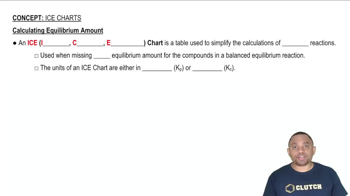Here are the essential concepts you must grasp in order to answer the question correctly.
Chemical Equilibrium
Chemical equilibrium occurs when the rates of the forward and reverse reactions are equal, resulting in constant concentrations of reactants and products. At this state, the system is dynamic, meaning that reactions continue to occur, but there is no net change in concentration. Understanding this concept is crucial for calculating equilibrium concentrations.
Recommended video:
Chemical Equilibrium Concepts
Equilibrium Constant (K)
The equilibrium constant (K) is a numerical value that expresses the ratio of the concentrations of products to reactants at equilibrium, each raised to the power of their coefficients in the balanced equation. It provides insight into the position of equilibrium and helps predict how changes in concentration, temperature, or pressure will affect the system.
Recommended video:
ICE Table (Initial, Change, Equilibrium)
An ICE table is a tool used to organize the initial concentrations, the changes in concentrations as the reaction proceeds, and the equilibrium concentrations of reactants and products. By setting up an ICE table, one can systematically calculate the equilibrium concentrations based on the initial conditions and the stoichiometry of the reaction.
Recommended video:
ICE Charts and Equilibrium Amount




